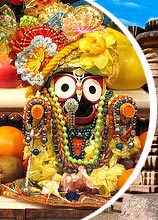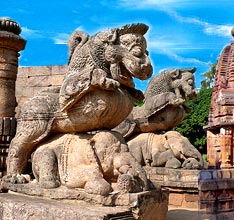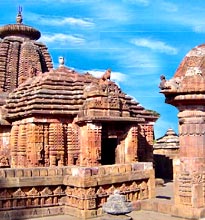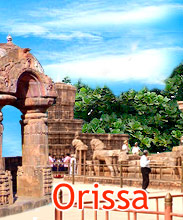 As
per the archaeological evidences, Odissi dance of Orissa can easily
claim to be amongst the earliest classical dances of India. The most
authentic proof of this are the carvings of dancing figures on the Rani
Gumpha caves, built during 2nd century BC at Udaygiri. Experts claim
that these carvings are much older than the famous writings of
Natyashastra, by Bharata, in which Odissi is described as a unique
dancing style of southeastern India.
As
per the archaeological evidences, Odissi dance of Orissa can easily
claim to be amongst the earliest classical dances of India. The most
authentic proof of this are the carvings of dancing figures on the Rani
Gumpha caves, built during 2nd century BC at Udaygiri. Experts claim
that these carvings are much older than the famous writings of
Natyashastra, by Bharata, in which Odissi is described as a unique
dancing style of southeastern India.Apart from the mention in old manuscripts and architecture, it is the Maharis and the Gotipuas dancers who hold the credit for keeping the tradition of Odissi classical dance alive. Maharis are the traditional 'devadasis' or temple dancers of Orissa who danced to the tunes of the great Geet Govinda, written by Jayadev. Before Jayadev's time, they mainly danced to Sanskrit mantras and shlokas. Though the Mahari and Gotipua tradition has mostly waned, Odissi dance continues to reign, courtesy the dedication of the dancers practicing this art form.
Unlike Maharis, Gotipuas were male dancers who danced in the garb of women. Many well-known senior Odissi dancers in the present times had once been Gotipua dancers. The main reason that led to the emergence of Gotipuas can be accorded to the Vaishnavites, who disapproved dancing by women. One finds the Odissi repertoire full of ashtapadis from Jayadeva's Geet Govinda, based on songs about Krishna and his consort, Radha.
The Maharis and Gotipuas are still remembered, but today it is the great Gurus coming from the same tradition that guide the destiny of Odissi. They have created a new generation of highly adept Odissi dancers, who have taken the responsibility of taking forward the tradition of Odissi dancing. Many have added their own personal touch to this traditional dance, keeping it in the constant state of evolution. Odissi has had many renowned gurus like late Padmavibhushan Guru Kelucharan Mohapatra, late Guru Pankaj Charan Das, late Guru Deb Prasad Das, etc.









